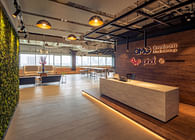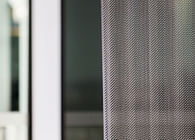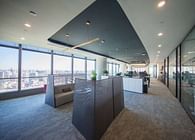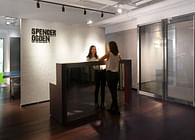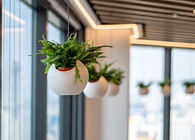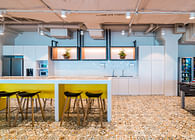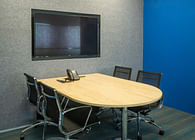
Gurgaon, New Delhi, IN | Singapore, SG | Bangkok, TH | Bangalore City, IN | Mumbai, IN | Hyderabad, IN | Pune, IN | Beijing, CN | Chennai, IN | Hong Kong, HK | Makati, PH | Melbourne, AU | New York, NY | Shanghai, CN | Sydney, AU
Sales meetings, client presentations, experience zones, focused work areas — in most offices, workplace design has to accommodate a combination of all these needs in varying degrees. However, every once in a while, we see a workplace strategy-driven mainly by one primary function alone.
We recently had the opportunity to create just such a unique strategy for the Gartner Centre For Excellence in Gurgaon. As a company that delivers actionable, objective insight to executives and their teams, Gartner’s employees are their greatest asset. So when they were conceptualising this new space, they wanted to take a more talent-focused approach. Unlike their other Halo offices which cater to their IT, sales and client service functions this Centre For Excellence was to be an R&D hub where employees would work and potential new hires would be interviewed. The workspace design, thus, had to be highly talent-driven and designed around in-office, focused work.
This was a unique challenge indeed, and here are a few ways in which we met this need:
1. Design language
The first and most obvious way in which we implemented this is through a rich design language that is best enjoyed as an in-person experience. As employees and potential candidates enter through the 12th floor lobby, they are immediately taken by the gorgeous marble flooring, the plush rugs and sofas, and the soothing timber elements — all offset by soft overhead lighting.
This luxe, hospitality-inspired look and feel carries through the entire office and is a great reflection of the brand’s global appeal. The design elements and colour palette offer consistency to the office interiors across all floors. Walking through the space, you will see a lot of wood tones, natural marble and stone textures, and soothing blue, grey and aqua hues. Yet, you will see design variations too, through patterned rugs, hand-finished tiles and Mandala motifs that all change in tone and texture while still staying within the colour family. Apart from offering variations, these patterns and motifs also bring a touch of the local aesthetics to the space.
In fact, these local manifestations are another important part of the design language that help add fun and whimsy through the space — and they are incorporated in the most unexpected ways. For instance, a cosmopolitan café space may feature a local graphic as a wall accent; a work area with an otherwise urban vibe leads to a corridor lined with lockers with eclectic patterns and a completely different vibe. One great example of how this interplay of aesthetics comes together is the wrap-around corridor that runs through every floor. With neutral ceilings and concrete-finished walkways, these corridors are consistent enough to function as a wayfinding device. But the walls lining the corridors also feature graphic elements showcasing fun vignettes from the streets — from kitsch trucks and taxis to horses, camels and even cricket.
2. Focused workspaces
While collaboration and social spaces are all given due importance, focused work and quiet contemplation are a huge part of how employees actually work here at Gartner. This is facilitated through well-design focused work zones and quiet areas. Employees all have assigned seats that make up their own little nook in the office — they can retire to these spaces after meetings and team sessions to do a bit of individual, heads-down work. These workspaces are sectioned off from the noisy social spaces, so people can really concentrate. Next to these work areas, there are little cubbies and lockers for each employee, which further add a sense of belonging, and afford people yet another little space to call their own.
Employees who are looking for some deep focus can head to the Quiet Areas for a change of pace. These areas feature acoustic booths to muffle noises and seats with visual partitions that help cut down distractions even further. Apart from these, each neighborhood also has cozy breakout spaces. These spaces have comfy sofas, wicker swing seats, soothing lights and lots of indoor greenery, making these the perfect spots to sit, relax and recharge.
3. Social spaces and recreation areas
In-person bonding through social interactions, fun and games make up an important part of Gartner’s workplace culture and this is strategically planned and implemented in this new office. The reception, the cafeteria and all the other major social spaces are housed on one dedicated floor. The cafeteria is a wide-open space that can accommodate up to 450 people. It has lightweight furniture that can be moved around to create various configurations, thus catering to groups of different sizes. This cafeteria leads on to training rooms, lounges and a coffee shop.
But the social opportunities are not limited to one floor alone — each level boasts of two social hubs like the Tech Café. These hubs are where one can have a casual meeting or enjoy personal interactions with colleagues over a cup of coffee. If the discussions lead to a more formal meeting, they can head to the adjoining meeting rooms or phone booths as needed.
Recreation is given serious thought here at this office too, and there are ample opportunities on each floor for employees to amuse and entertain themselves. Each level has a recreation zone — all featuring a different activity that people can enjoy. For instance, there’s a ping pong table on Level 11, with brightly colored paddles covering one wall. Over at Level 10, one can challenge their colleagues to a game of pool. Level 12 features a one-of-a-kind, permanent installation in the form of a VR cricket pitch, making this the first office to have such an entertainment offering.
3. Collaboration spaces
Unlike many other modern workplaces, the collaboration areas at the Gartner R&D Hub are not just casual, multi-purpose areas where people can sit, lounge, work and collaborate all from one space. Instead, each zone is designed to cater to a particular need. This makes in-person collaboration a lot more purposeful and focused.
For instance, the colorful step seating area is meant for casual, more dynamic discussions — and employees will find different kinds of seating options, writing surfaces and digital screens to enable this. A few paces away, there’s another collaboration zone that is designed for more immersive discussions and presentations. This features a plush sofa that faces a large screen, and it can be sectioned off from the rest of the office with a partition. This office is also where recruitment drives are carried out, so there are hubs and closed meeting rooms specifically for that.
5. Well-being and sustainability features
Aside from the need for superior air filtration systems brought on by the pandemic, outdoor air quality levels in Gurgaon see seasonal variations too — this prompted us to set up RESET® certified centralized and decentralized air purification systems and IAQ monitors for a real-time view of indoor air performance. Planters, green walls and other biophilic elements were also introduced to improve air quality and mimic the outdoors so as to reduce stress and elevate productivity levels.
This LEED- and WELL-certified workplace was designed to give every workstation access to good exterior views and healthy exposure to sunlight. This was a deliberate strategy to boost wellness — research has shown a 6.5% reduction in sick leave when offices are designed with good views and suitable daylighting. The overall energy savings from this move would also reduce operational costs and further Gartner's sustainability agenda.
Active workstations featuring height-adjustable desks, ergonomic chairs, monitor arms, treadmill desks and balance boards are a key feature of the R&D Hub, helping employees build workspaces that suit their unique ergonomic and fitness needs. This enabling approach is evident even in the human-centric lighting fixtures and daylight and occupant sensors. By aligning to our natural circadian system and increasing visual comfort, such simple yet thoughtful additions can potentially lead to a 23% increase in alertness and a 19% increase in work performance.
The employee-centric focus is evident in the rest of the office too. Mindful eating is promoted through designated eating spaces away from the workstations, while separate recreation spaces, quiet zones and gaming rooms have been set up to refuel the mind. The R&D Hub also has a safe and amenity-rich mother's room to make the office experience as comfortable as possible for women re-entering the workspace after maternity breaks.
Status: Built
Location: Haryana, IN
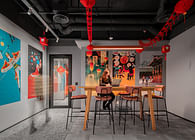
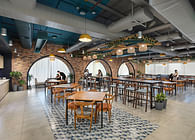
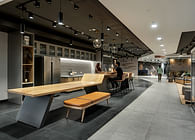


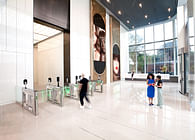
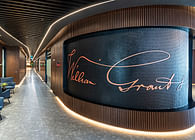


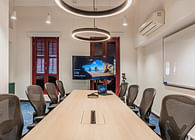

![Welcome to the Space Matrix [β] Lab (Beta Lab): Explore | Experiment | Evolve your workplace at our workplace Welcome to the Space Matrix [β] Lab (Beta Lab): Explore | Experiment | Evolve your workplace at our workplace](https://archinect.gumlet.io/uploads/a2/a299a4d482050f4cde0c2319362274b2.jpg?fit=crop&auto=compress%2Cformat&enlarge=true&crop=entropy&w=195&h=140)
![Welcome to the Space Matrix [β] Lab (Beta Lab): Explore | Experiment | Evolve your workplace at our workplace Welcome to the Space Matrix [β] Lab (Beta Lab): Explore | Experiment | Evolve your workplace at our workplace](https://archinect.gumlet.io/uploads/c6/c640bc99dae2fa43f4703128358c0869.jpg?fit=crop&auto=compress%2Cformat&enlarge=true&crop=entropy&w=195&h=140)
